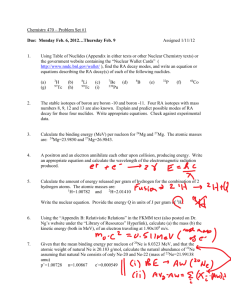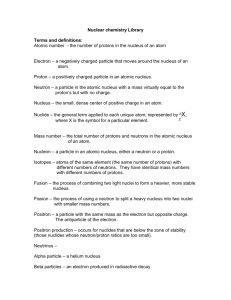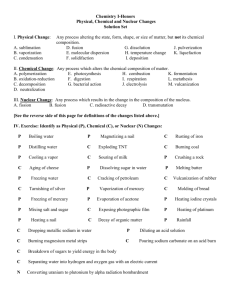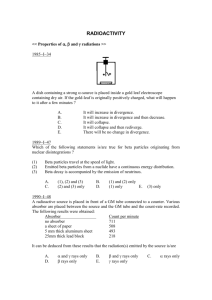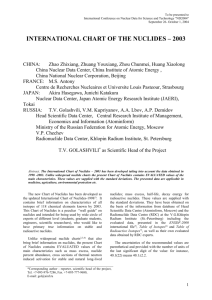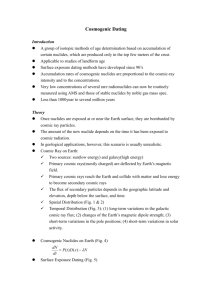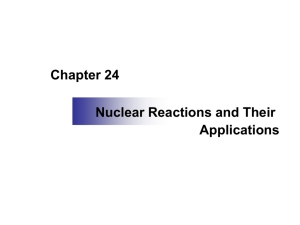Chart of Nuclides Lab: Nuclear Science Guide
advertisement
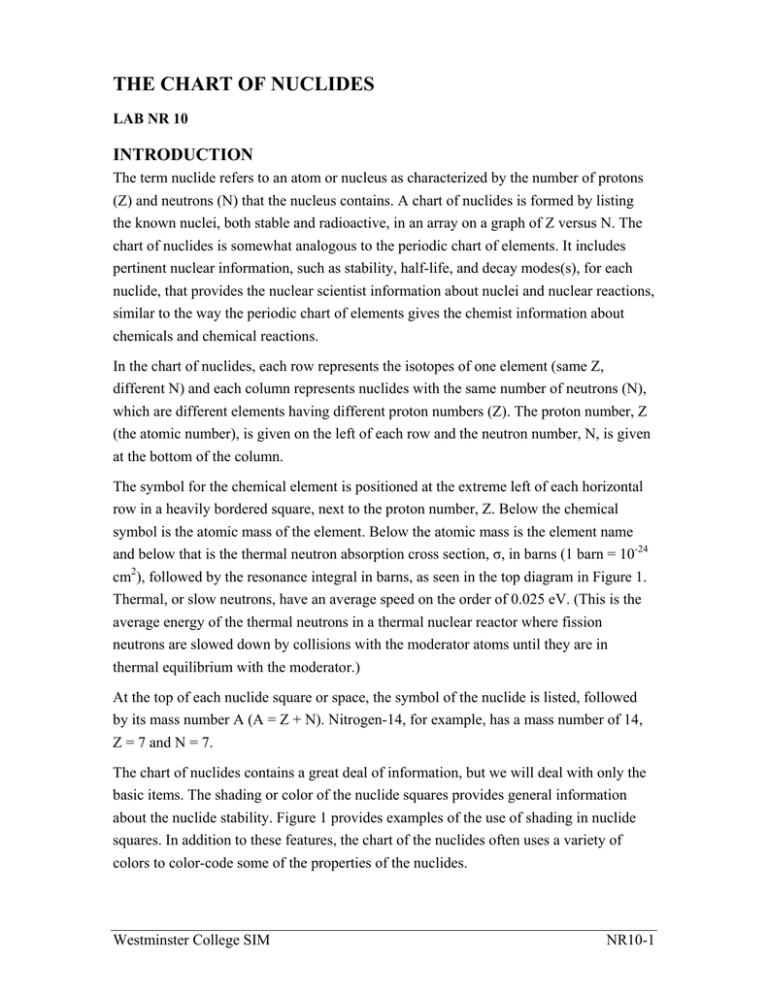
THE CHART OF NUCLIDES LAB NR 10 INTRODUCTION The term nuclide refers to an atom or nucleus as characterized by the number of protons (Z) and neutrons (N) that the nucleus contains. A chart of nuclides is formed by listing the known nuclei, both stable and radioactive, in an array on a graph of Z versus N. The chart of nuclides is somewhat analogous to the periodic chart of elements. It includes pertinent nuclear information, such as stability, half-life, and decay modes(s), for each nuclide, that provides the nuclear scientist information about nuclei and nuclear reactions, similar to the way the periodic chart of elements gives the chemist information about chemicals and chemical reactions. In the chart of nuclides, each row represents the isotopes of one element (same Z, different N) and each column represents nuclides with the same number of neutrons (N), which are different elements having different proton numbers (Z). The proton number, Z (the atomic number), is given on the left of each row and the neutron number, N, is given at the bottom of the column. The symbol for the chemical element is positioned at the extreme left of each horizontal row in a heavily bordered square, next to the proton number, Z. Below the chemical symbol is the atomic mass of the element. Below the atomic mass is the element name and below that is the thermal neutron absorption cross section, σ, in barns (1 barn = 10-24 cm2), followed by the resonance integral in barns, as seen in the top diagram in Figure 1. Thermal, or slow neutrons, have an average speed on the order of 0.025 eV. (This is the average energy of the thermal neutrons in a thermal nuclear reactor where fission neutrons are slowed down by collisions with the moderator atoms until they are in thermal equilibrium with the moderator.) At the top of each nuclide square or space, the symbol of the nuclide is listed, followed by its mass number A (A = Z + N). Nitrogen-14, for example, has a mass number of 14, Z = 7 and N = 7. The chart of nuclides contains a great deal of information, but we will deal with only the basic items. The shading or color of the nuclide squares provides general information about the nuclide stability. Figure 1 provides examples of the use of shading in nuclide squares. In addition to these features, the chart of the nuclides often uses a variety of colors to color-code some of the properties of the nuclides. Westminster College SIM NR10-1 The Chart of Nuclides INTERPRETING SHADING IN NUCLIDE SQUARES 1. Gray-shaded squares ─ indicate isotopes that occur in nature and are generally considered stable (including isotopes with a lower limit for t½ of 5 x 108 years).. 2. White or “color” squares ─ indicate artificially produced isotopes. (Some charts of nuclides are color coded concerning the range of half-lives and neutron absorption properties. See the specific chart for information.) 3. Black rectangles across the top of square a. On gray-shaded squares, this marking designates the species as radioactive nuclides found in nature with very long half-lives [e.g. Nd-144 (t1/2 = 2.38 x 1015 years)]. Because of the long half-lives, these nuclides are considered generally stable. b. On white or colored squares, this marking designates the species as radioactive nuclides found in nature, color-coded for half-lives from 5 x 108 years to less than 1 day (white)[e.g. blue-shaded, C-14 (t1/2 = 5715 years) and white, Bi-215 (t1/2 = 7.6 minutes)]. 4. Smaller black rectangle near top of square ─ indicates that the nuclide is a member of a natural radioactive decay chain. The historic symbol is inserted in the black area, for example, Ra A for Po-218 and UX1 for Th-234. 5. Black triangle at bottom corner of square ─ indicates that the nuclide is formed by fission of U-235 or Pu-239, for example Xe-140 and Sr-94 in the induced fission reaction 235 92 U + 01 n → 140 54 Xe + 94 38 Sr + 2( 01 n ) Xe-140 and Sr-94 are radioactive. In other instances, the resulting nuclides may be stable, e.g., Pd-108. 6. Vertically divided square ─ indicates a nuclide with isomeric or metastable states. The nuclide possesses states of different radioactive properties. The nuclei of the different states of particular nuclide are called nuclear isomers. These have the same Z and N numbers, but different radioactive properties. The isomeric states have different energies, the lower energy state is commonly referred to as the ground state and the higher energy levels are referred to as isomeric states. The ground state is often a stable nuclide. If two isomers exist, the higher-energy state is shown on the left. If three isomers exist, the highest-energy state is shown on the left, with the intermediate-energy state either below it or to the right of it, and the ground state either on the far right or below the other isomers. Each nuclide square displays an extensive variety of data. The data pertinent to this experiment is explained below and examples are provided in Figure 1. Westminster College SIM NR10-2 The Chart of Nuclides Figure 1 Examples of the data display in the chart of nuclides. Chemical Element Symbol Atomic Mass (Carbon Scale) H Element Name 1.00797 Hydrogen σa .333, .150 Even Z, Even N Nuclides Have Spin and Parity 0+ Stable Thermal Neutron Capture CrossSections in Barns Leading to (Isomeric + Ground State), Followed by Resonance Integrals Leading to (Isomeric + Ground State). Pd 108 26.46 σγ (.19+8), (2+24E1) 107.903895 Isotopic Mass (Carbon-12 Scale) Thermal Neutron Absorption Cross Section in Barns Followed by Resonance Integral, in Barns Symbol, Mass Number Atom Percent Abundance Activation Cross Section in Barns to Two Isomers Isotopic Mass (Carbon-12 Scale) Fission Product, Slow Neutron Fission of U235, U233 or Pu239 Artificially Radioactive Modes of Decay with Energy of Radiation in MeV for Alpha and Beta; keV for Gammas. S 38 2.84 h β .99,… γ 1941.9,… E 2.94 Symbol, Mass Number Half-life Beta Disintegration Energy in Mev Naturally Occurring or Otherwise Available but Radioactive Spin and Parity Symbol, Mass Number La 138 5+ Atom Percent Abundance Modes of Decay in Order of 0.090 Half-Life Prominence with Energy of Radiation 1.05E11a ε, β- .25 in MeV for Alpha and Beta; keV for γ 1435.8,788.7 Gammas. σγ ~57, 4E2 Beta Disintegration Energy Followed Thermal Neutron Capture Cross E 1.04 137.90711 by Isotopic Mass Section, Followed by Resonance Integral Member of Naturally Radioactive Decay Chain Historical Symbol Modes of Decay and Energy in MeV for Alpha and Beta; keV for Gamma Westminster College SIM Po 218 RaA 3.10m α 6.0024 γ 510 β- ω 218.008965 Symbol, Mass Number Half-life Isotopic Mass NR10-3 The Chart of Nuclides Figure 1, continued Examples of the data display in the chart of nuclides. Spin and Parity of Metastable State, 11/2־ Half-life Modes of Decay with Energy of Radiation in keV Isotopic Mass Two Isomeric States One Stable 11/- Sn 17117 1/+ 1/+ 13.60d 7.68 7.68 IT 156.0, eσγ 1.1, γ 158.6 ~15 ~15 116.902955 Radioactive Isomer Spin and parity of Metastable State Thermal Neutron Capture CrossSection in Barns Followed by Resonance Integral in Barns Spin and Parity of Ground State, ½+ Symbol, Mass Number Atom Percent Abundance Thermal Neutron Capture CrossSection in Barns, Followed by Resonance Integral in Barns Fission Product, Slow Neutron Fission of U235,U233 or Pu 239 Stable Ground State Two Isomeric States Both Radioactive Spin and Parity of Ground State Symbol, Mass Number 60 5+ 5+ 2+ Co 60 a 10.47 m 5.271 5.271a Half-lives .318, IT 58.6,e-β-β.318, Modes of Decay and Energy in Order β-1.6ω,••• ••• of intensity; … Indicates(where γ1332.5 γ 1332.5 γ1332.5 … shown) Range of Energies Included ω,••• 1173.2 6E1, σγ 2.0, 4 σγ6E1, Beta Disintegration Energy in MeV 2.3E2 2.3E2 E2.824 Radioactive m-State Isomer Radioactive g.s. Isomer Symbols representing radiations and decays α ββ+ γ n p d t ε IT D SF E eβ-βC14 Ne alpha particle negative electron (beta decay) positron gamma ray neutron proton deuteron triton electron capture isomeric transition delayed radiation spontaneous fission disintegration energy conversion electron double beta decay particle emission (C14 nuclei) particle emission (neon nuclei) Westminster College SIM Symbols representing units of time ns µs ms s m h d a nanosecond (10-9s) microsecond (10-6s) millisecond (10-3s) second minute hour day year NR10-4 The Chart of Nuclides Figure 2 Diagrams showing the relative locations of the products of various nuclear FIGURE 2 processes and displacements caused by nuclear reactions. Figure 2a. Relative locations of the products of various nuclear processes. 3 He in α in p in d in t in Original nucleus n in β- out n out t out α out d out 3 β+ out ε p out He out Figure 2b. Displacements caused by nuclear bombardment reactions. α,3n p, α Westminster College SIM α,2n 3 He,n p,n p,γ d,n 3 He,np p, pn γ,n n,2n Original nucleus n,n n,t γ,np n,nd n,d γ,p n,np n,α n,n3He n,3He n, pd α,n α,np t,n 3 He,p d,p n,γ t,np t,p n,p t,3He NR10-5 The Chart of Nuclides IDENTIFYING DATA IN NUCLIDE SQUARES 1. Gray-shaded squares (stable nuclides) a. First line ─ Symbol and mass number. b. Second line ─ Atom percent abundance, which is the percent of the natural element occurring as this isotope. c. Third line ─ Thermal neutron cross-section. d. Fourth line ─ Atomic mass of the nuclide atom, which is the mass of the nucleus and surrounding electrons. 2. Black-topped gray-shaded squares (long-lived radioactive nuclides found in nature) Second line ─ Atom percent abundance, followed by half-life and modes(s) of decay with decay particle energy in MeV for alpha and beta and keV for gamma. When more than one mode of decay occurs, the most prominent mode appears first (above or to the left of the other modes). 3. White squares (artificially produced radioactive nuclides) Similar to black-topped gray squares with atom percent abundance absent. Isomeric states have similar displays. Some charts of nuclides have color coding for the range of half-lives and neutron absorption cross-sections. The half-life coding generally appears in the upper half of the nuclide square and the cross-section coding in the bottom half. The color codes are defined on each chart. The arrangement of the chart of nuclides allows rapid determination of the nuclide change when a nuclear process occurs, whether it occurs naturally or artificially. Figure 2 illustrates the method used to make this determination. METHOD OF DETERMINING NUCLIDE CHANGE 1. Induced reactions ─ For an induced reaction for which the original nucleus and the incident, or “in” particle is known, the compound nucleus of the reaction is given in the square of the “in” particle. For example, for the induced reaction of Be9 being bombarded by an alpha particle, 9 4 Be + α → the compound nucleus is two squares diagonally upward to the right (refer to Figure 2a), 9 4 Be + 42 He → ( 13 6 C *) A neutron is the “out” particle in this reaction; therefore, the product nucleus is one square to the left of the compound nucleus C-13, which is the square of C-12: ( )→ 13 6C* Westminster College SIM 12 6C + 01 n NR10-6 The Chart of Nuclides In equation form, the total reaction is: 9 4 Be + 42 He → ( 13 6 C *) → 12 6 C + 01 n Using abbreviated notation, the reaction is: 9 Be(α , n )12 C Figure 2b combines this process and the product nucleus is given directly by the location of the reaction particles. 2. Radioactive decay ─ In this case, the concern is only with the “out” particle, and the location of the daughter nucleus is obtained according to Figure 2a. For example, C-14 (the parent nucleus) beta-decays (β-), so the daughter nucleus is one square diagonally upward to the left (i.e., N-14). Similarly, F18 undergoes positron decay (β+, a positively charged “electron”) and the daughter nucleus O-18 is one square diagonally downward to the right. PURPOSE The purpose of this activity is to become familiar with The Chart of Nuclides and its use to interpret the basic information it provides. EQUIPMENT/MATERIALS Chart of nuclides 4 sheets of Cartesian graph paper (optional) PROCEDURE After completing the Preliminary Questions, answer the questions in the Laboratory Report using a chart of nuclides. References: Wilson, J. D., Physics Laboratory Experiments; 2nd ed.; D. C. Heath and Company, pp 497-505. Chart of the Nuclides, 15th ed.; General Electric Co. and KAPL, Inc., 1996. Westminster College SIM NR10-7 The Chart of Nuclides PRELIMINARY QUESTIONS Name ________________________ Period _______ Class ___________ Date ___________ THE CHART OF NUCLIDES Read the experiment and answer the following questions. 1. What is a nuclide? 2. What is the chart of nuclides? 3. How are natural stable isotopes and natural long-lived radioactive isotopes distinguished on the chart? 4. How are artificially produced isotopes and natural short-lived radioactive isotopes distinguished on the chart? 5. What are nuclear isomers, and how are they distinguished on the chart? 6. What is the difference between the mass number and the atomic mass of a nuclide? 7. List the change(s) in the proton number (Z) and/or the neutron number (N) for the following nuclear processes and give the relative location of the daughter nucleus to that of the parent nucleus on the chart. a. alpha decay b. beta minus (β-) decay c. beta plus (β+) decay d. gamma decay Westminster College SIM NR10-8 The Chart of Nuclides LABORATORY REPORT Name ________________________ Name ________________________ Period _______ Class ___________ Date ___________ THE CHART OF NUCLIDES 1. How are the isotopes of an element arranged on the chart? 2. Nuclides with the same number of neutrons are called isotones. How are they arranged on the chart? 3. Nuclides with the same mass number are called isobars. What would be the orientation of a line connecting an isobaric series? 4. List all of the naturally occurring generally stable nuclides* that have an odd number of protons and an odd number of neutrons. Also, comment on the ratio of neutrons to protons for increasingly heavier nuclides. (*Stable or with extremely long half-lives (> 109 years). List the stable nuclides and the long-life radioactive nuclides separately.) 5. List the percent abundances of the naturally occurring nuclides of (a) oxygen; (b) uranium. Do they add up to 100 percent? If not, explain. Westminster College SIM NR10-9 The Chart of Nuclides 6. List the elements that have only one stable isotope. 7. Which element(s) has the greatest number of stable isotopes? Give the number of isotopes. 8. Which element(s) has the greatest number of radioactive isotopes? Give the number of isotopes. 9. List an example radioactive nuclide and its half-life for each of the following halflife ranges: a. µs (microseconds, 10-6) b. s c. min d. h e. days f. years 10. Which nuclide on the chart has (a) the shortest life; (b) the longest half-life? List their half-lives. 11. A large number of different product nuclides typically result from the slow neutron fission of U-235, U-233, and Pu-239. In analyzing “The Chart of Nuclides” (16th edition), nearly 550 such product nuclides are noted with 100 of these indicated as stable. Such fission products from slow neutron fission of U-235, U-233, and Pu239 are indicated on the chart by small black triangles or squares in the lower right corner of the nuclide squares. Whether the nuclide is stable is denoted by some gray shading in the nuclide squares. Answer the following regarding these stable fission product nuclides. Westminster College SIM NR10-10 The Chart of Nuclides a) range of: Z, ___ to ___. N, ___ to ___ A, ___ to ___ b) radio of N to Z: from ______ to ______. c) Regarding odd and even counts of N and Z with respect to stability, one notes that 79 of these nuclides are even Z and 21 nuclides are odd Z which suggests that even Z are about ______ times more likely than odd Z. Further, for these even Z nuclides 53 have even N and 21 have odd N so that for the even Z even N is about ______ times more likely than odd N. 12. For the following fission reactions, fill in the blanks with the missing isotopes, including Z and N numbers. 235 1 92 U + 0 n 235 92 U 13. → _______ → 144 56 Ba + _______ + 3 01 n + 01 n → _______ → _______ + 94 38 Sr + 2 01 n (Do the following on a separate sheet of paper and attach to the Laboratory Report.) Beginning with the following radioactive parent nuclei, trace their decay processes and depict the mode and direction of each decay process on the chart. For example, 14 N 13a. β− 14 C 20 O 20 Ne β20 F β20 (a)O-20, Westminster College SIM O NR10-11 The Chart of Nuclides 13b. 52 Cr 52 Fe β+ 52 Mn β+ 52 Cr (b) Fe-52, 13c. 197Po 197 Po 6.381 MeV α 193 Pb ε 193 Tl ε, β + 193 Hg ε, β + 193 Au ε 193 Pt - e 193 Ir (c) Po-197, Westminster College SIM NR10-12 The Chart of Nuclides 13d. 150Dy 150 Dy 4.235 MeV α ε, β + 146 Gd ε 150 Tb 3.49 MeV α 146 Eu ε, β + ε, β + 2.73 MeV α 146 α 142 Na 150 Gd Sm 2.455 MeV (d)Dy-150 (list the energies of the emitted alpha particles in this decay process beside the directional arrows), 13e. 162Ho 162 Ho ε, β + 162 Py (e) Ho-162. 14. (Do the following exercise on separate sheets of paper or, preferably, graph paper if it is available.) Beginning with the following radioactive parent nuclei, trace the decay “chains.” List the modes and direction of the process on the chart as on part 13. The first three decay chains are found in nature, but the fourth chain is not. Westminster College SIM NR10-13 The Chart of Nuclides 14 (a). 238U (Uranium series) 234 U 210 Po (stable) 230 Pb Th β- α 206 218 Rn 210 β- Bi α 206 Tl β β- Po Pb α 206 Hg - U β- Ra α β α Bi 222 218 α α 210 Tl Th Rn Po β- α 234 α - 214 β- Pa 226 At β- 238 234 α 218 α 210 β α 214 - β- α 238 U, t½ = 4.47 x 109 yr 214 Pb a. U-238 (uranium series) 14 (b). 235U (Actinium series) 227 Th β- α 231 Pa 223 Ra 211 Po (stable) Pb β- At Bi Tl β- α 211 207 α 215 β- α 207 Po β- β Rn 215 α Ac Pb α At 215 Bi Th Fr 219 211 α 231 223 β- β- α U α 219 α α 227 - 235 β- 235 U, t½ = 7.04 x 108 yr α b. U-235 (actinium series) 14 (c). 244Pu (Plutonium series – originally called thorium series) 240 Pu α 228 Th 224 Ra 212 (stable) 208 Pb Po α β - 208 Tl α β α β- 220 - Rn α 212 Bi α β - 212 Pb 224 Fr β- 236 240 U β- Np α 228 Ac α 232 β- 244 Pu α β240 Th U α 228 Ra 216 Po α 244 Pu, t½ = 8.0 x 107 yr c. Pu-244 (plutonium series–originally called the thorium series beginning with Th-232 before Pu-244 was discovered.) Westminster College SIM NR10-14 The Chart of Nuclides 14 (d). 237Np (Neptunium series) 233 U α 225 Ac α 217 Rn (stable) Bi Fr β- α 213 β Po - 217 213 Bi β- 233 Pa 225 Ra 237 Np, t½ = 2.14 x 106 yr α 209 Pb Th α At β- α Np α 229 β- 221 α 209 237 β- α 209 Tl Not found in nature with the t½ = 2.14 x 106 yr giving it adequate time on a cosmic scale to decay. (Earth age: ~4.6 x 109 yrs.) d. Np-237 (neptunium series) Why is this series not found in nature? 15. Using the chart of nuclides, supply the product nucleus of each of the following reactions. Also, give the compound nucleus of each reaction. Product Nucleus Compound Nucleus a. 10 ______________________ b. 16 ______________________ c. 7 d. 17 e. 32 S(n,p) ___________________ ______________________ f. 3 H(d,n) ___________________ ______________________ g. 2 H(t,n) ___________________ ______________________ B(n,α) ___________________ O(n,p) ___________________ Li(p,γ) ___________________ ______________________ O(γ,np) ___________________ ______________________ Westminster College SIM NR10-15
